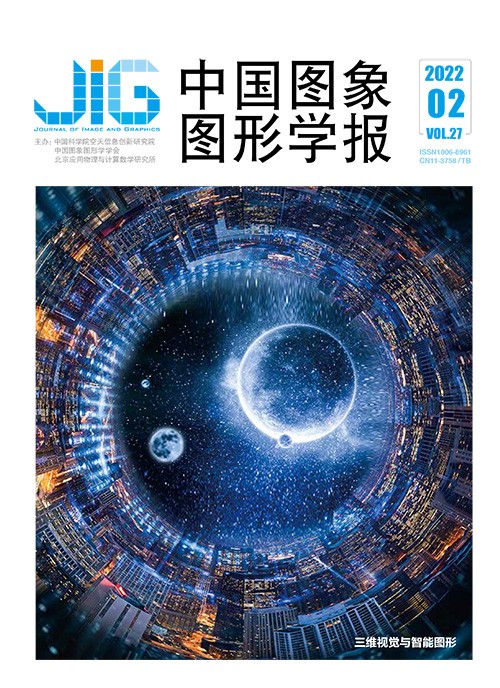
多特征融合与几何卷积的机载LiDAR点云地物分类
摘 要
目的 点云分类传统方法中大量依赖人工设计特征,缺乏深层次特征,难以进一步提高精度,基于深度学习的方法大部分利用结构化网络,转化为其他表征造成了3维空间结构信息的丢失,部分利用局部结构学习多层次特征的方法也因为忽略了机载数据的几何信息,难以实现精细分类。针对上述问题,本文提出了一种基于多特征融合几何卷积神经网络(multi-feature fusion and geometric convolutional neural network,MFFGCNN)的机载LiDAR (light detection and ranging)点云地物分类方法。方法 提取并融合有效的浅层传统特征,并结合坐标尺度等预处理方法,称为APD模块(airporne laser scanning point cloud design module),在输入特征层面对典型地物有针对性地进行信息补充,来提高网络对大区域、低密度的机载LiDAR点云原始数据的适应能力和基础分类精度,基于多特征融合的几何卷积模块,称为FGC (multi-feature fusion and geometric convolution)算子,编码点的全局和局部空间几何结构,实现对大区域点云层次化几何结构的获取,最终与多尺度全局的逐点深度特征聚合提取高级语义特征,并基于空间上采样获得逐点的多尺度深度特征实现机载LiDAR点云的语义分割。结果 在ISPRS (International Society for Photogrammetry and Remote Sensing)提供的3维标记基准数据集上进行模型训练与测试,由于面向建筑物、地面和植被3类典型地物,对ISPRS的9类数据集进行了类别划分。本文算法在全局准确率上取得了81.42%的较高精度,消融实验结果证明FGC模块可以提高8%的全局准确率,能够有效地提取局部几何特性,相较仅基于点的3维空间坐标方法,本文方法可提高15%的整体分类精度。结论 提出的MFFCGNN网络综合了传统特征的优势和深度学习模型的优点,能够实现机载LiDAR点云的城市重要地物快速分类。
关键词
Semantic segmentation of airborne LiDAR point cloud based on multi-feature fusion and geometric convolution
Dai Mofan, Xing Shuai, Xu Qing, Li Pengcheng, Chen Kun(Institute of Geospatial Information, Strategic Support Force Information Engineering University, Zhengzhou 450001, China) Abstract
Objective Airborne laser scanning (ALS) offers a mature structure of point cloud data, which can represent complicated geometric information of the real world. Point cloud classification is a critical task in airborne laser detection and ranging applications, such as topographic mapping, power line detection, building reconstruction, etc. However, unavoidable reasons, such as complicated topographic conditions, sensor noise and sparse point cloud density, make ALS point cloud classification very difficult. Original point cloud classification is dependent on manual features, targeted classification conditions and parameter designation. Deep learning-based methods transform 3D point cloud into other representations such as 3D voxels, 2D images and octree structures based on structured networks at the cost of 3D spatial structure information loss. As the requirement for high point cloud density, the lack of adaptability for data and deep features caused in accuracy. Moreover, some networks make multi-modal data fusion or learn multi-level feature representations of points via local structures exploration, but the applications of geometric information of airborne data is constraint to achieve fine-grained classification for geometrically prominent and diverse ALS point cloud. In this paper, we propose a multi-feature fusion and geometric convolutional neural network (MFFGCNN) consisting of ALS data processing, multi-feature fusion and deep geometric features aggregation for point cloud classification. Method First, an ALS point cloud design module, called APD module, is constructed to organize point cloud structure by balancing classes and scale, partitioning point cloud and processing raw coordinates. Next, discriminative typical features are used to supplement the point cloud information at the input feature level. The applications of echo and intensity has been demonstrated as input along with the coordinates into the point-based network, which can preserve the 3D spatial characteristics while making full use of the effective point cloud features. Then, four types of geometric features of points and their K-nearest neighborhoods are calculated by dividing the neighborhood region at three different scales, with local spatial information. A geometric convolution module based on multi-feature fusion, called multi-feature fusion and geometric convolution(FGC) operator, is to encode the global and local spatial geometric structure of points. This design can obtain the hierarchical geometric structure of large area point clouds. At the end, our method aggregates the discriminative deep global and local geometric features in different levels and the input multi-class features into a hierarchical advanced semantic feature, which enables semantic segmentation of airborne LiDAR(light detection and ranging) point clouds by spatial up-sampling. Result The comparative analyses are based on the International Society for Photogrammetry and Remote Sensing (ISPRS) 3D labeling benchmark dataset. For the three typical ground features of buildings, ground and trees, the dataset is further divided on initial contained nine categories such as car, facade and shrub. The ALS point cloud is segmented into blocks of 50 m as a batch input into the network. Each feature is extracted from the layer and then processed using batch normalization. The batch number for training and evaluation is 16 and the maximum epoch during training is 200. The test is implemented via a NVIDIA GTX 2060Ti GPU. Mean intersection-over-union (mIoU), mean accuracy (mAcc), and overall accuracy (OA) are evaluated. The results of ablation experiments demonstrate that the FGC module can improve the global accuracy by 8%, which can effectively extract local geometric features. Compared with the 3D spatial coordinate-based method, the overall classification accuracy can improve by 15%. The relative elevation of the neighborhood can reflect elevation directional heterogeneity and ground points can achieve clear classification. Echo features can be validated for advantage in vegetation classification. The introduction of geometric features facilitates the distinction between building points and background points while ensuring the consistency of the building's main body and clear contours. The four classes of geometric features are targeted at the curvature variation, edges, all consistency of the feature and the unique spherical characteristics of the vegetation. It illustrated further that the involvement of multiple classes of features in the semantic segmentation of airborne LiDAR point clouds. The visualization results also demonstrate a stronger model, especially in difficult situations such as buildings surrounded by tall trees and dense buildings with complex roof structures still achieving excellent performance, but there is a potential for improvement in the edges of features, and in the detailed parts of complex scenes. Conclusion The proposed MFFCGNN network combines the advantages of initial features and deep learning-based models. The demonstrated model can be implemented in 3D city modelling.
Keywords
point cloud classification airborne LiDAR PointNet++ deep learning multi-feature fusion geometric convolutional network(GCN)
|



 中国图象图形学报 │ 京ICP备05080539号-4 │ 本系统由
中国图象图形学报 │ 京ICP备05080539号-4 │ 本系统由